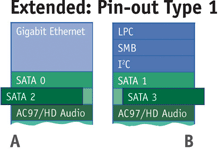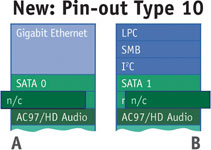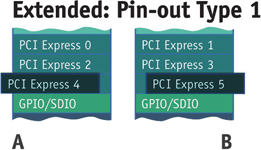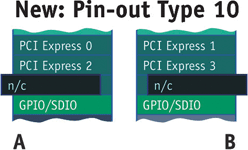
Five years after its début, the PCI Industrial Computer Manufacturers Group (PICMG) has now released revision 2.0 of the COM Express COM.0 computer-on-module standard. COM.0 Rev. 2.0 addresses the new functionalities that Intel, AMD and other manufacturers are integrating in their upcoming processor families.
Rev 2.0 adds two new pin-outs that make space for possible future technologies by dropping a number of interfaces that are less useful. The growing significance of graphics and displays is evident in the changes made to the COM Express specification. These optimisations now make smaller COM Express form factors possible. Even with the changes to the specification, the pin-out types produced to date will continue to be available with new generations of chips, thereby ensuring the scalability of existing applications.
In the COM Express COM.0 specification, the PICMG defines the standard for a computer-on-module (COM) as a bootable host computer in the form of a single large-scale integrated component. The vendor-independent specification of interfaces and form factors for computer-on-modules gives designers and solution providers a firm basis on which to develop products that are future-oriented and promise long-term availability.
PICMG continues along the right path with the Rev 2.0 of the COM Express specification. OEMs that set up their medical diagnostic apparatus, industrial robots and vending machines, test and measurement applications, POS and kiosk systems, surveillance cameras or unmanned vehicles on COM Express modules have chosen a sustainable and innovative solution for the future. When these designers elect to migrate to a more compact form factor, COM Express COM.0 Rev. 2.0 will afford them a seamless transition, thanks to the newly specified compact form factor (95 x 95 mm). Kontron has offered the compact form factor under the registered trademark microETXexpress since 2006.
A change that is a little less apparent but which has a great impact is the addition of two new pin-outs to the five already defined pin-out types within the COM Express specification. Seven pin-out types are now defined in Rev. 2.0. These can be split into two groups differing initially in the number of connectors they utilise. Pin-out types 1 and the new pin-out type 10 utilise the single A-B connector that has 220 pins, which can also be found on all other pin-out types. But types 2, 3, 4, 5, as well as the new type 6 also use the second 220-pin connector – the C-D connector – so they possess a total of 440 pins.
Let us now look at the features of the individual pin-out types as specified in COM.0 Rev. 2.0.
Taking stock - pin-out types 1 through 5
Pin-out type 1: This has one 220-pin connector – the A-B connector - and supports up to eight USB 2.0 ports, up to four SATA or SAS ports, and up to six PCI Express Gen1/Gen2 lanes. It supports dual 24-bit LVDS, an HDA digital audio interface, Gigabit Ethernet and eight GPIO pins. SPI is added to all single pin-out types in Rev. 2.0 on previously reserved pins (this will be covered in more detail later in this paper; see the section on external BIOS boot). The primary input voltage is +12 V and standby is +5 V. Some solutions such as Kontron’s COM Express module allow a variable input voltage.
Pin-out type 2 has all the stated functionality of type 1, but adds a second 220-pin connector to it as well (C-D). In this case, type 2 features a 32-bit PCI interface plus IDE ports to support legacy PATA devices such as PATA HDD and CompactFlash memory cards. There are a total of 22 PCI Express lanes (six on the A-B connector and up to 16 on the C-D connector), 16 lanes on the second connector being intended for PCI Express Graphics (PEG). The maximum power consumption, previously defined as 188 W, is now matched to 137 W in Rev. 2.0, thanks to ever more energy efficient processors.
Comparing pin-out type 3 to type 2, only the IDE pins are used in favour of extra Gigabit Ethernet capability. Consequently, it has no legacy interfaces, but now supports up to three Gigabit Ethernet channels. In pin-out type 4, again compared to type 2, pins reserved for PCI are reallocated, creating space for 10 additional PCI Express lanes. These can be used as PCIe lanes 0-15 or as second PEG port lanes 16-31. Pin-out type 5 fuses the changes in types 3 and 4 as compared to type 2.
Pin-out type 6 opens up a new world of graphics. PICMG has added this sixth type of pin-out to the COM Express standard especially to utilise the expanded graphics possibilities of new processor families. This pin-out type is essentially based on type 2, the most widely adopted COM Express COM.0 pin-out type to date. Legacy PCI pins are now used to support the digital display interface and for additional PCI Express lanes. Furthermore, in pin-out type 6, the pins previously assigned to the IDE interface in pin-out type 2 are now reserved for future technologies still in development. One of these technologies could well be SuperSpeed USB, because the 16 free pins would offer sufficient lines to implement four of the eight USB 2.0 ports as USB 3.0 ports that each require an extra pair as compared to USB 2.0.
Extensive support for additional display interfaces
Although pin-outs type 2 and 6 are very similar, type 6 adds extensive support for additional display interfaces. The graphics options have always been one of the special strengths of COM Express through support of PEG that has been chosen by Intel to provide a high-speed bus for external graphics cards. But these days it is not only a matter of satisfying the growing need for performance, but of supporting different output devices as well. And these are precisely the kind of requirements for which pin-out type 6 has been scaled.
Like virtually all the other pin-out types (except type 10), pin-out type 6 continues to support the familiar analog VGA, the standard interface for RGB/CRT devices used in many industrial applications. Because of the analog transmission of the picture signal, VGA is not entirely suitable for modern TFT displays with resolutions of more than 1280×1024. LVDS (low-voltage differential signalling) devices can also be driven directly by all pin-out types. This is important for applications with LCD displays, for example, which mainly use this transmission standard. Here it should be noted that the dual 24-bit LVDS channels are designed for one display; the second channel serves solely to process the increasing data rates caused by higher resolution and frequency. The connected LVDS display defines how many channels are needed for each resolution.
From SDVO to DisplayPort
Pin-out type 6 goes far beyond these graphics options. It offers three new ports that are dedicated to new digital display interfaces (DDI). The developer can configure these ports individually for HDMI (high-definition multimedia interface) or the electrically compatible DVI (digital visual interface) or DisplayPort (DP). DDI port 1 additionally supports SDVO (serial digital video output). SDVO is not multiplexed on the PEG port in type 6, which has been possible under the pin-out type 2 definition. Thus, in parallel with embedded graphics, an external PEG graphics card can be used, for example, for multimonitor applications with more than four screens or for data processing using general purpose GPUs (GPGPU).
With the SDVO interface supported by Intel chipsets, COM Express is flexible in supporting a wide variety of graphics signals. So the developer can now implement DVI (digital visual interface), for example, and achieve relatively low-cost integration of digital monitors and dual display solutions. COM Express previously did not officially support SDVO, but it has also become part of the COM Express standard in the new COM.0 Rev. 2.0.
The developer can also operate modern DisplayPort and HDMI/DVI graphical interfaces through the DDI. DisplayPort is a universal and – unlike HDMI – royalty-free interconnect standardised by VESA, which should ensure its widespread popularity. DisplayPort not only has a much higher data transfer rate of 17,28 Gbps (compared to 2,835 Gbps with LVDS and 4,95 Gbps with DVI), but also a micro-packet protocol, allowing simple expansion of the standard. Furthermore, DisplayPort supports an auxiliary channel that allows a bidirectional connection to control devices by VESA standards such as E-DDC, E-EDID, DDC/CI and MCCS. This enables genuine plug-and-play operation. The auxiliary channel can be used for peripherals such as touch-panel displays, USB connects, cameras, microphones, etc.
DisplayPort could eventually replace HDMI, popular on the consumer market, which as mentioned above is also supported by the COM Express standard on the DDI. HDMI is an ideal solution for AV and multimedia applications, such as home theatre PCs or set-top boxes, due to its high data rate, its connector concept (audio and video on one cable), and its backward compatibility. However, this interface was not developed for the embedded market. Its implementation does not make for a particularly stable solution, plus long-term availability could also be a problem as drivers or mechanical requirements frequently change.
With this extensive support for the new graphics and display functionalities of upcoming chipsets, pin-out type 6 is a promising follow-on to pin-out types 2 and 3 and comes at the right time. Kontron already anticipated this development in a number of areas, so developers who want to make full use of the new graphics possibilities of COM Express are well served. Given its experience, Kontron can provide developers with optimal support when migrating from pin-out types 2 or 3 to pin-out type 6 and help to ensure a seamless transition. So, with the ETXexpress-AI, Kontron also presented one of the first type 6 modules in the basic form factor.
10 for 1
The major innovation that COM.0 Rev. 2.0 represents is the definition of the new pin-out type 10, a kind of twin brother to pin-out type 1. Type 10 addresses the requirements of newer and highly compact processors more explicitly. A close look at the pin assignments reveals the differences to watch out for when migrating from type 1 to this new type, although both pin-out types are compatible with each other.
In pin-out type 1, SATA ports 2 and 3 are assigned pins in rows A and B, but these are no longer reserved in pin-out type 10. The pins could still be used as SATA ports, but are now reserved for alternative purposes such as USB 3.0. So in designs for pin-out type 1 as for type 10, Kontron advises against wiring SATA 2 and 3 over the module connector. The modules then remain compatible, and they are ready for USB 3.0 at the same time. Figure 1 illustrates the differences.


Figure 2 shows another difference in rows A and B, this time regarding the pinning of the PCIe lanes, where pin-out type 1 offers six lanes in total. In pin-out type 10, the pins for PCIe lanes 4 and 5 are no longer reserved and can also be used for upcoming technologies. The background in both the above cases is as follows: processors of a small form factor, at which type 10 aims, support up to two SATA interfaces and four PCIe lanes. The vacated pins on the module connectors of the ultra standard can therefore be used efficiently for new purposes.


This article will be concluded in a future issue of Dataweek.
| Tel: | 087 093 2700 |
| Email: | [email protected] |
| www: | www.osiris.co.za |
| Articles: | More information and articles about Osiris Technical Systems |

© Technews Publishing (Pty) Ltd | All Rights Reserved